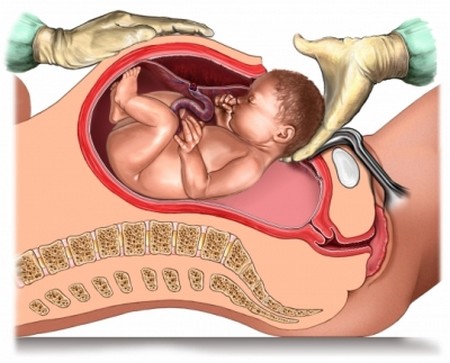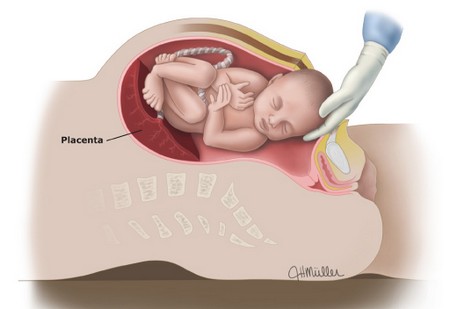Best Way to Deliver Your Baby with Cesarean Section
Several conditions that arise during pregnancy or during labor may necessitate a delivery by cesarean section (c-section). You may know you have a very strong chance of having a cesarean delivery before going into labor. Your doctor or midwife has been watching your pregnancy all along. Recent examinations may have revealed that your baby seems too large for your pelvis. This is called cephalo-pelvidis-proportion (CPD).
Your baby’s head might be too large to go through the birth canal, your pelvis shape cannot accommodate a normal size baby’s head, or the baby could be in a position that would put strain on its head during birth. Or for other reasons, your doctor may have warned you that a vaginal delivery would be difficult or ill-advised. If you’re carrying twins, you already know you are more likely to have a cesarean delivery, and if you’re carrying a higher number of multiples, then you are almost certain to have a cesarean delivery.
Babies in the breech or transverse position are more likely to be delivered surgically. If you’ve developed a complication during pregnancy, such as pregnancy induced hypertension or diabetes, your doctor will probably prepare you for the possibility that your baby will arrive by c-section.
Two conditions for cesarean cannot be predicted because they occur after labor is underway. Failure to progress is a common reason for needing a cesarean. Another reason is fetal distress, which would be revealed by the fetal monitor. It means your baby is exhibiting signs that he or she is not doing well during labor. If this is the case, the goal is to get your baby delivered quickly and safely.
Most cesareans can be performed using a regional anesthesia, such as an epidural or spinal block. You will be awake for the surgery and your partner can be by your side. Only very rarely does the surgery require general anesthesia. If you do need general anesthesia, you will be asleep and your partner cannot attend the surgery. The procedure is usually so quick that the anesthesia does not affect your baby.
Preparation
If your doctor decides your baby should be delivered by cesarean, a team of operating room medical staff will prepare you for surgery. You may be given a medication to dry the secretions in your mouth and upper airway and reduce acid in your stomach. Your pubic and abdominal region will be shaved and cleaned with sterile solution. Usually, a catheter is inserted into the urethra to drain urine. This keeps the bladder empty, so it’s unlikely to be injured during the surgery. An IV line will be placed in your arm or hand or wrist to deliver fluids and medications during the surgery. Once you are in the operating room, you’ll also have the tubing in place in your back for an epidural or spinal block. Once on the operating table, sterile draping will shield you from a view of the incision.
The Surgery
To perform a cesarean, your obstetrical surgeon will make incisions through your skin, through some other layers of tissue, and finally through the uterus. The uterine incision may be horizontal across the lower part of your abdomen or one of two kinds of vertical cuts. Once the uterine wall is open, your doctor will push down on your uterus just below your chest, to help the baby out of the uterus. This won’t hurt but may feel like he or she is pulling on your midsection. Your baby is lifted out and his or her care proceeds as with a vaginal birth. You may be able to stroke your baby while your incision is being closed.
The total surgical event usually takes less than an hour. You will be wheeled to the recovery room and eventually to your hospital room after the doctor repairs your incision. Your vital signs will be checked once you’re in the room and every few hours for the next 24-hour period.
Recovery from a Cesarean
The catheter in your bladder will be removed after surgery, but your IV will remain in place for one to two days or until you can take food and drink by mouth. As the anesthesia wears off, you will be very sore and in pain. Your doctor will prescribe pain medication. Let your doctor know if you need more. While you’re in the hospital, a nurse will probably show you how to press a pillow into your stomach when getting in and out of bed to minimize the pain. You’ll be encouraged to get up frequently. If you’ve had general anesthesia, you will be encouraged to try to cough up secretions from your lungs.
If you are planning to breast-feed your baby, you’ll be encouraged to try nursing your baby. A lactation consultant is usually available, but don’t hesitate to ask for guidance from your nurse. Your baby may not latch on easily at first, but try to stick with it. Get help and support with positioning your baby for breastfeeding after a cesarean surgery. As with other kinds of surgery, recovery will take three to four weeks. You should not drive for two weeks. You will be instructed on how to look for signs that your incision may be infected.
Categories
Advertisements
Recent Articles
 How to Understand Bed Sizes – A Small Guide
How to Understand Bed Sizes – A Small Guide How to Select Some Must Have Kitchen Accessories
How to Select Some Must Have Kitchen Accessories Best Way to Change a Car Tire
Best Way to Change a Car Tire Best Way to Write an Affirmation
Best Way to Write an Affirmation Best Way to Take Charge of Your Financial Life
Best Way to Take Charge of Your Financial Life Best Way to Survive a Party When You Don’t Know Anyone
Best Way to Survive a Party When You Don’t Know Anyone Best Way to Stop Self Sabotaging Yourself
Best Way to Stop Self Sabotaging Yourself Best Way to Start Journal Writing
Best Way to Start Journal Writing Best Way to Speak with a Powerful Voice
Best Way to Speak with a Powerful Voice Best Way to Simplify Your Life
Best Way to Simplify Your Life Best Way to Respond to a Put-Down
Best Way to Respond to a Put-Down Best Way to Reduce Acne Breakouts
Best Way to Reduce Acne Breakouts Best Way to Recover from Dining Disasters
Best Way to Recover from Dining Disasters Best Way to Quit Your Job Gracefully
Best Way to Quit Your Job Gracefully Best Way to Make Your Own Website
Best Way to Make Your Own Website



Leave a Reply